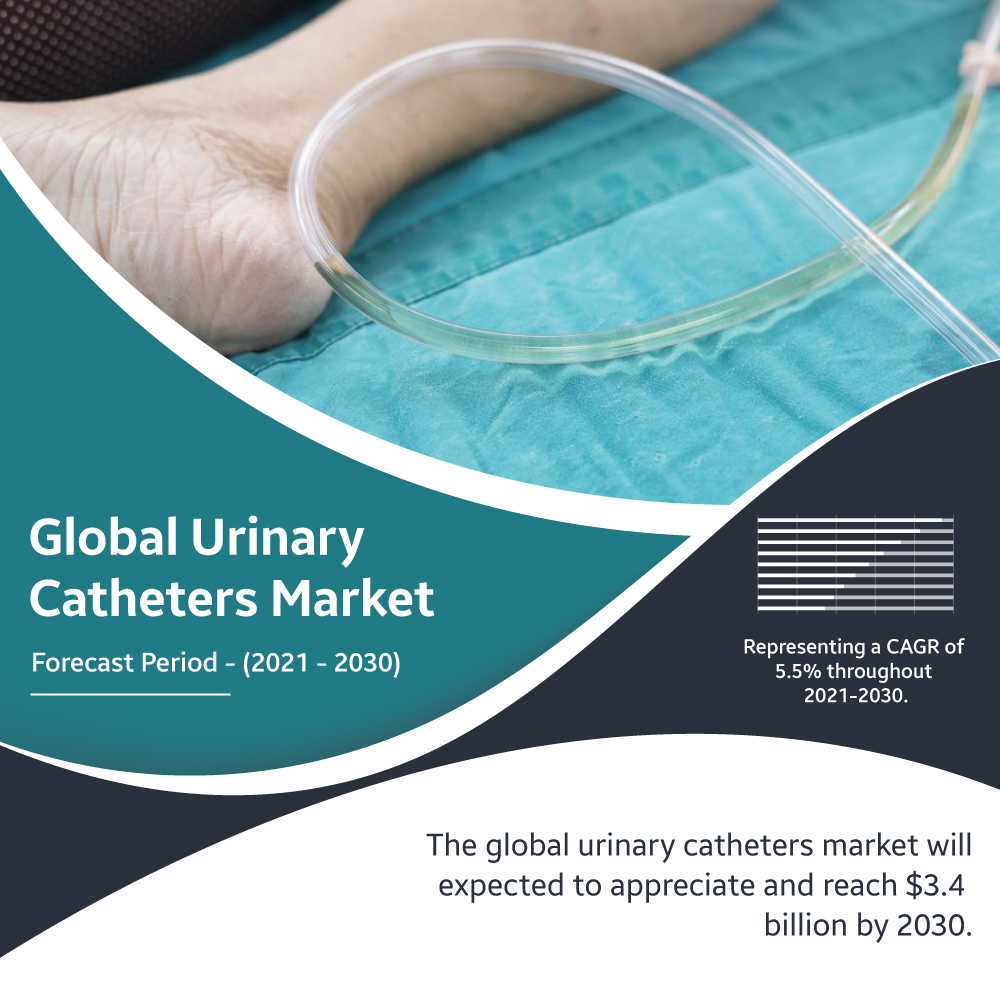A hollow flexible tube called a urinary catheter is inserted into the body to empty and gather urine from the bladder. These catheters are made of silicone, rubber, or plastic (PVC) and are available in various shapes and sizes. When a person is unable to urinate, they are required. Renal failure, which can be deadly and result in long-term kidney damage, may be caused by the pressure urine buildup places on the kidneys. These are suggested by a doctor if a patient has urine incontinence, urinary retention, or is unable to control when they urinate.
The market worth of urinary catheters in 2021 was USD 2.11 billion and will reach USD 3.4 billion by 2030 at a 5.5% CAGR.
The primary factors driving the expansion of the industry include an increase in surgical procedures performed globally, a good reimbursement environment, a rise in urinary incontinence prevalence, and a high incidence of prostate cancer.
Drivers
The primary reason for the increasing need for urinary catheters worldwide is the high prevalence of urine incontinence. According to the International Continence Society, urge urinary incontinence affected 63 million people worldwide in 2018. These trends will boost the demand for urinary catheters as a therapeutic alternative for persons with urine incontinence. The elderly and nursing home patients have higher incidence rates. Urinary catheters are utilized when medicinal or surgical treatment for incontinence is ineffective.
Additionally, the market for urinary catheters will expand positively throughout the forecasted period due to technical developments in the sector. Leading market participants might focus on creating sophisticated urinary catheters that offer catheterization, lessening the risk of leakage and infection while minimizing discomfort and resentment from urethral problems.
Restraints
The patient must endure a painful procedure to have a catheter placed. If poorly lubricated catheters are utilized for insertion and removal, friction could develop between the device’s surface and the urethral walls. This is an important factor that can limit the market’s overall expansion.
Opportunities
The market for urinary catheters has enormous potential for growth in developing nations like Mexico, Brazil, China, India, and Brazil. Future growth potential can be ascribed to a rising number of regulatory body approvals, an expanding patient population, rising healthcare costs, and advancements in the healthcare infrastructure.
Market Segmentation
Product Insights
On the basis of product, the market is segmented into external catheter, indwelling catheter, and intermittent catheter.
In 2021, the market was ruled by the intermittent catheters segment, with the biggest revenue share of more than 57%. For patients with spinal cord injuries and neurogenic bladder issues, intermittent catheterization is the gold standard for emptying the bladder. Indwelling catheters are not recommended in favor of these devices because they frequently cause UTIs. The segment is expanding in part because these catheters are covered by the Medicaid and Medicare programs.
Application Insights
On the basis of application, the urinary catheter market is segmented into general surgery, urinary incontinence, bengin prostatic hyperplasia, and other.
In 2021, the urinary incontinence market segment recorded the largest share of 37%. The growing size of the industry is blamed for the rise in obesity, the rise in the elderly population, and the rise in urinary incontinence.
As per the American Urological Association, UI affects one-third of the population and affects women more frequently than males. It affects long-term care facilities significantly and is one of the key factors that seniors are admitted for institutionalized care.
Regional Insights
Most of the market is ruled by Asia-Pacific and generated USD 565.1 million in 2021. With a CAGR of 6.67%, it will rise to USD 1,010.42 million in 2030. Due to recent advancements in the healthcare sector and the general state of the health infrastructure in developed nations like India, China, and Japan, the Asia-Pacific region is currently the world’s market leader for urinary catheters. Additionally, the dense population in Asia-Pacific enables marketers to conceal a sizable consumer base. As a result, there are ongoing efforts by the regulatory authorities to increase the urinary catheter’s value in the worldwide urinary catheters market, particularly in India and Japan.
Key Players
- Boston Scientific Corp.
- Becton Dickinson And Company (C.R. Bard, Inc.)
- Hollister, Inc.
- Medtronic PLC
- Cook Medical
- J and M Urinary Catheters LLC
- Teleflex, Inc.
- Medline Industries, Inc.
The market worth of urinary catheters in 2021 was USD 2.11 billion and will reach USD 3.4 billion by 2030 at a 5.5% CAGR. Some of the major reasons influencing the market growth include the rising cases of malignancies in the urinary tract or reproductive organs, an increase in patients with urethral obstructions and UTIs, and the fast-expanding geriatric population.















































